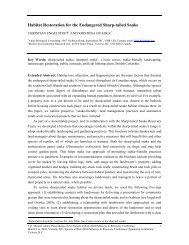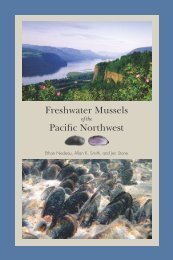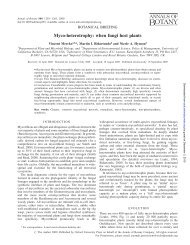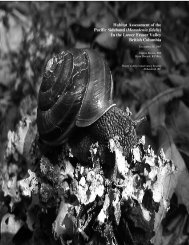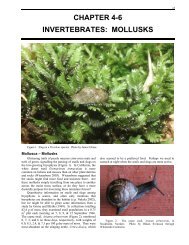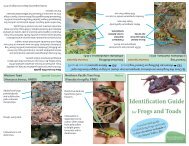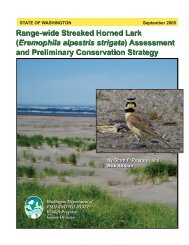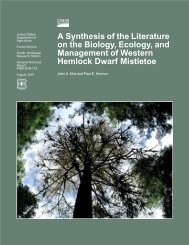Coastal Cutthroat Trout as Sentinels of Lower Mainland Watershed ...
Coastal Cutthroat Trout as Sentinels of Lower Mainland Watershed ...
Coastal Cutthroat Trout as Sentinels of Lower Mainland Watershed ...
You also want an ePaper? Increase the reach of your titles
YUMPU automatically turns print PDFs into web optimized ePapers that Google loves.
6drainages where cutthroat trout were sparsely distributed in contr<strong>as</strong>t to coho salmon(Slaney and Northcote 2003). Thus, a key strategy is to provide public education on theirvalues <strong>as</strong> sentinels <strong>of</strong> watershed quality and health. Provision <strong>of</strong> “benchmarks” <strong>of</strong>abundance <strong>of</strong> juvenile cutthroat in streams should be used <strong>as</strong> indicators <strong>of</strong> populationhealth. Thus, it is important that urban municipal planning fully accounts for cutthroatinhabited watersheds, with cutthroat abundance <strong>as</strong> an indicator <strong>of</strong> watershed health.Some further work is needed to define benchmark densities and biom<strong>as</strong>ses which varywith stream productivity.2. Habitat Protection via Land Acquisitions <strong>of</strong> Critical <strong>Cutthroat</strong> HabitatsAt several cutthroat streams, particularly in the Fr<strong>as</strong>er Valley, there are small criticalnursery are<strong>as</strong>, many <strong>of</strong> which are located on alluvial fans at the b<strong>as</strong>e <strong>of</strong> mountain slopes.Some are wall-b<strong>as</strong>ed channels where there is groundwater recharging <strong>of</strong> surface channels.These streams are <strong>of</strong>ten threatened by agricultural practices which include inv<strong>as</strong>ivedredging and riparian alterations. Further, some key nursery are<strong>as</strong> may be at risk fromfuture urban developments. Land purch<strong>as</strong>es through the Habitat Conservation Trust Fund(HCTF) for conservation <strong>of</strong> these critical nursery habitats would ensure they wereprotected and preserved. Further, once secured for conservation, those nursery habitatsdamaged by p<strong>as</strong>t agricultural and land clearing impacts could be restored. Actionsrequired by the Ministry are (1) identification <strong>of</strong> these critical cutthroat-coho nursery fansand their land are<strong>as</strong> and status; (2) discussions with representatives <strong>of</strong> the AgriculturalLand Reserve and municipalities regarding land deposition subject to land owner interestin sale <strong>of</strong> specific small parcels <strong>of</strong> private land; and (3) negotiation <strong>of</strong> purch<strong>as</strong>eagreements with land owners subject to availability <strong>of</strong> conservation funding.Alternatively, these critical nursery reaches may be protected by purch<strong>as</strong>ing conservationcovenants. Regardless <strong>of</strong> the approach, their identification should be a habitatmanagement priority.3. Recovery <strong>of</strong> Extirpated <strong>Cutthroat</strong> StocksOf a total <strong>of</strong> 657 streams located from Maple Ridge to the West Vancouver, 120 streamshave been lost (in-filled, culverted, paved over) during the p<strong>as</strong>t 100 years <strong>of</strong> landsettlement and urbanization (Precision Identification Biological Consultants 1997).Many <strong>of</strong> them were significant anadromous cutthroat producers which have been reducedto mere remnants such <strong>as</strong> Como Creek. Among other urban streams that still exist,cutthroat trout have been extirpated over their length or much <strong>of</strong> their length by culvertobstructions and/or poor water quality, <strong>as</strong> at Nelson Creek. As a first priority, a tally <strong>of</strong>extirpated cutthroat streams and stream reaches needs to be completed. Thereafter, pilotrecovery projects <strong>of</strong> extirpated cutthroat streams should be funded and implemented togarner public interest and support, further advancing the concept <strong>of</strong> cutthroat trout <strong>as</strong>sentinels <strong>of</strong> watershed health. A concerted effort should be made to gain activecooperative municipal involvement that results in pollution abatement, re-establishment<strong>of</strong> native cutthroat by re-stocking juveniles and provision <strong>of</strong> fish access at culvertbarriers. Community stewardship is needed to monitor and maintain healthy conditions.



